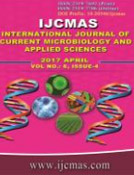


 National Academy of Agricultural Sciences (NAAS)
National Academy of Agricultural Sciences (NAAS)

|
PRINT ISSN : 2319-7692
Online ISSN : 2319-7706 Issues : 12 per year Publisher : Excellent Publishers Email : editorijcmas@gmail.com / submit@ijcmas.com Editor-in-chief: Dr.M.Prakash Index Copernicus ICV 2018: 95.39 NAAS RATING 2020: 5.38 |
Staphylococcus aureus is one of the most common organisms causing nosocomial and community acquired infections worldwide. Antibiotic resistance in this organism has become an ever-increasing problem. Present study was undertaken to determine the percentage of Staphylococcus aureus isolates having inducible clindamycin resistance. A total of 270 Staphylococcus aureus isolated from different specimens were subjected to routine antibiotic sensitivity testing by Kirby Bauer disc diffusion method. All isolates were tested for Methicillin resistance by using Cefoxitin 30 μg disc. Inducible clindamycin resistance was detected by ‘D’ test as per CLSI guidelines. Among the 270 S. aureus isolates, 124 (45.92%) were detected as MRSA, 116 S. aureus isolates (42.96 %) were resistant to Erythromycin and 41 (15.16 %) isolates were D-test positive. Both inducible and constitutive clindamycin resistance was higher among MRSA compared to MSSA. High prevalence of strains with inducible clindamycin resistance particularly among MRSA indicates that inducible clindamycin resistance testing (D-test) should be included as a part of routine antibiotic susceptibility. These isolates may be missed in routine antibiotic testing by disk diffusion method.
 |
 |
 |
 |
 |